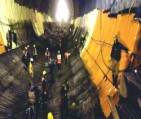Microtunneling is an efficient trenchless technique for the construction of small diameter utility tunnels (approximately 500mm to 4,000mm in diameter). This construction method is employed to accurately install pipelines under existing utilities, highways, railroads, levees, waterways, in sensitive wetlands, unstable ground conditions, and contaminated soils with minimum disruption to businesses and traffic on the surface.
Microtunneling is desirable for its ability to reduce project risk, constrain the construction zone within easements and right of ways, minimize ground surface settlement, and is applicable to a wide range of geological and changing ground conditions with extreme accuracy. It offers precise line and level installations in various ground conditions. The main applications of microtunnelling are in sewerage, drinking water, oil and gas, communication and power supply networks.
It is used for laying large diameter gravity sewers in cities where open cut installation is difficult, for the installation of product pipelines in areas where the soil condition does not allow for horizontal directional drilling and for long individual crossings across rivers.
Microtunneling is currently the most accurate pipeline installation method. Line and grade tolerances of one inch are the microtunneling industry standard. This can be extremely important when trying to install a new pipeline in an area where a maze of underground utility lines already exists.
Due to the small diameter of these tunnels, it is not practical for an operator to drive the tunneling machine; therefore, a remotely controlled Microtunnel Boring Machine (MTBM), which are operated remotely from a control room typically at ground level, combined with the pipe jacking technique is employed for construction to directly install product pipelines underground in a single pass. This process avoids the need to have long stretches of an open trench for pipe laying, which causes extreme disruption to the community.
Microtunnel Boring Machine (MTBM)
Microtunnel boring machines (MTBMs) are very similar to conventional larger tunnel boring machines (TBMs), but on a smaller scale. These smaller diameter tunnels are generally controlled remotely with laser-guided steering by an operator at the surface rather than sitting in the machine itself. MTBMs use high-end guided systems with live monitoring for real-time correction capability. Through a computer console and precise control equipment, the operator receives continuous data about the location and orientation of the MTBM as well as data about the other parts of equipment.
The micro tunnel boring machine typically consists of a cutting head, an auger, a shield, and a trailing support system. The cutting head is used to cut and shape the tunnel while the auger is used to remove the soil and transport it to a designated storage area. The shield provides stability and support during the construction process while the trailing support system is used to install the pipeline or other utility.
In most microtunnel projects, a MTBM is launched through an entry eye and pushed by hydraulic jacks from a launch shaft and pipe sections are pushed behind the machine using the jacking frame. The pipe jacking process is repeated until the boring machine reaches the reception shaft at the far end. As the machine advances, more pipe sections are pushed from the launch shaft. Interjacking stations (IJS) can be inserted into the pipe string to provide additional jacking capacity, if needed. The speed of the advancing machine is limited to the speed at which the pipe is inserted into the entry eye via the hydraulic rams in the jacking frame.
Advantages of Microtunneling
Great accuracy and control
One of the biggest benefits of microtunneling is the level of accuracy and control it offers. Microtunneling’s accuracy has increased tremendously over the past few decades, which makes the technique useful when working within smaller easements or installing curved alignments with a consistent grade. In the old days, the tunnel would be a straight line, but microtunnel boring machines have the capability to tackle radiuses. MTBMs has the ability to correct the alignment very quickly and maintain the line and grade. During microtunneling, the pressure at the cutting face can be monitored, so there’s a smaller likelihood of settlement problems.
A good option for difficult ground
This method is best used in difficult ground conditions—like softer soils—but can be used to bore through all types of soil, sand, clay, and even hard rock. It works especially well below the groundwater table due to its sealed and pressurized face. This prevents groundwater and soil from flowing into the machine.
Useful for environmentally sensitive areas
Another benefit of microtunneling is that it causes minimal disruption to the environment around it, especially compared to open-cut construction. If the tunnel is to be constructed through environmentally sensitive or contaminated areas, microtunneling—like other trenchless tunneling options—will reduce the amount of contaminated material needed to be handle. This can be a big factor in some situations, like performing a deep excavation and it’s expensive to dispose of the contaminated material.
Safer working environment
Microtunneling also provides a safer working environment for those involved in the project. As most work takes place underground, workers don’t have to risk their safety by being exposed to machinery or heavy equipment aboveground. The safety also comes from remote work. Remote control naturally leads to greater safety for the controller, because instead of sitting near the head of the machine underground—like they would for a larger tunnel boring machine—a person can operate the MTBM from above ground.
Innovative curved drives
A surging trend in the microtunneling is curved drives. In combination with longer drive lengths, curved drives can lead to the elimination of intermediate shafts that can lower the cost of construction and reduce disruption on the surface. Longer drive lengths, compound curves, and now, tighter radii and larger diameters increase the range of what can be accomplished with microtunneling techniques.
Microtunneling may be a bit more expensive than other trenchless applications but is also one of the most capable. The accuracy, reliability, and lower maintenance cost of pipelines post-installation can make it a better choice.








